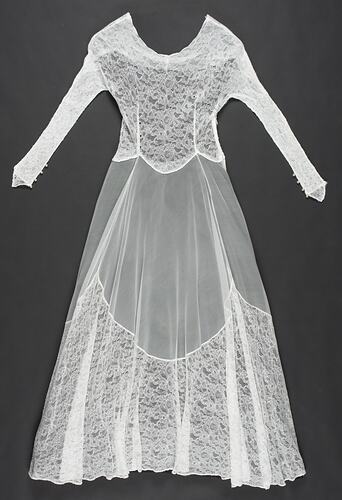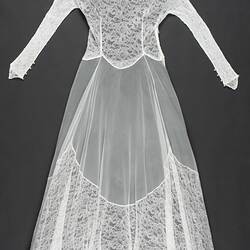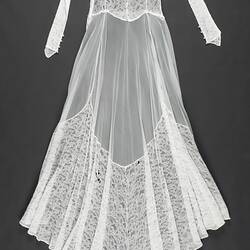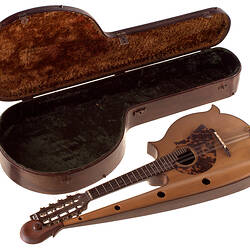Summary
Wedding dress which was worn by Carmela Palermo as a proxy bride in Calabria, Italy before migrating to Australia in 1957. It was commissioned by Carmela's mother, based on a style Carmela found in a magazine she had sent to her by her Italian fiance who was living in Australia. Carmela did not have a second wedding once arriving in Melbourne but did wear it again for her wedding portraits here.
Carmela Palermo (nee Rocca) was born in 1940 in Sambiase, Calabria in Italy. She migrated to Australia as a proxy bride in 1957, flying via Rome and landing at Essendon Airport. She married neighbour Vicenzo Palermo who had migrated to Australia five years previously. They married in Brunswick and settled in a very underdeveloped Keilor. Carmela brought a glory box with her which followed by ship (two travelling trunks), and included linen, a dinner set, and a trousseau. The migration experience was a very difficult one for Carmela, with no family (although her husband had family in Australia) nor English language proficiency, she was extremely lonely and isolated. It took many years for her to settle, seek education and make Australia her home.
Physical Description
White wedding dress made to fit a tiny female frame. It has a scoop scalloped neckline with long fine lace sleeves and 4 pearl buttons at each wrist. Also row of 13 pearl buttons in a row down the back and a white zip down the right hand side. The bodice is of fine floral pattern lace as are the sleeves. The skirt is in fine sheer net finished at three-quarter length and finished with the fine floral lace. The skirt flares out and hem tapers out to a point, longer at the back than the front.
Significance
Migration for marriage and in particular, the marriage 'by proxy' phenomenon, is a significant theme in the history of migration to Australia. Since the mid-nineteenth century Irish bride ships, women have been arriving in Australia over time as wives, brides and brides-to-be as part of chain migration, family reunion schemes and proactive government efforts to redress gender imbalances. This collection enables the exploration through material culture and memory the post-war proxy bride experience which dramatically impacted upon the lives of thousands of Italian, Greek, Maltese and other European women who travelled here in the 1950s and 1960s with high expectations of husbands, homes and families - expectations that frequently were not fulfilled.
More Information
-
Collection Names
Museums Victoria/Italian Historical Society Co.As.It Collection
-
Collecting Areas
-
Acquisition Information
Donation from Carmela Palermo, Nov 2006
-
User
-
User
Carmela Palermo, Brunswick, Greater Melbourne, Victoria, Australia, 1957
-
Classification
-
Category
-
Discipline
-
Type of item
-
References
Oral history interview (and transcript) conducted for Glory Box phd research project, 22/10/2007
-
Keywords
Brought Goods, Italian Communities, Italian Immigration, Marriage Customs & Rites, Proxy Brides, Wedding Costumes, Weddings



